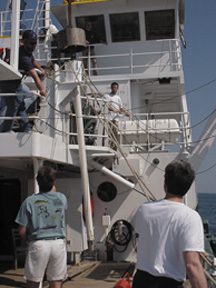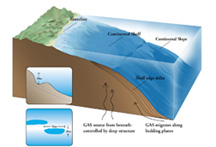geotimesheader
News
Notes
Natural
Hazards
Tsunami
news floods East Coast
Terror. Threat. Speeding waves. Tsunami. These
words hit news headlines like the Sunday paper hits your doorstep.
Whump.
All you wanted was the midweek paper, coffee and
15 minutes of early morning peace.
You swallowed a little more than French Roast
if you picked up USA Today on May 2 or The Washington Post
or The New York Times on May 3. Tidings of impending destruction
from a possible East Coast tsunami swept the headlines. The fear
of a killer wave striking the Mid-Atlantic coast crossed the gap between
the usual not-in-my-backyard dismissal and the mind-blowing notion that
the Washington Monument might be bobbing down the Potomac River like a
drifting buoy sometime in the near future.
Neal Driscoll of the Woods Hole Oceanographic
Institution, and fellow researchers John Goff of the University of Texas
and Jeffrey Weissel of the Lamont-Doherty Earth Observatory, discovered
inexplicable crack-like features on the continental shelf off the coast
of southern Virginia and North Carolina. They published their findings
in the May issue of Geology.
From sidescan images and bathymetric profiling
the scientists identified what they described as en echelon cracks spanning
40 kilometers in water depths of 100 to 200 meters. Directly to the south
of the cracks was a sediment slump that formed after the Ablemarle-Currituck
slide during the Pleistocene. They drew attention to the juxtaposition
of the two features as evidence for potential slope failure in the vicinity
of the newly discovered cracks. In their Geology article they concluded
that, “Given the risk to the coastal community, it seems wise to invest
effort to determine whether the en echelon cracks … are fossil features
or are active and likely to produce a potentially disastrous, large submarine
slide in the near future.” |

Lead researcher Neal Driscoll (bottom left) helped prepare the gravity
corer to take sediment samples. The samples were scheduled for analysis
to determine the origin of sediment-trapped gas off the coast of Vriginia
and North Carolina.
From the Woods Hole Oceanographic
Institution. |
On May 6, Driscoll and fellow researchers left
for a two-week research cruise to further investigate the sea-floor cracks.
What at first appeared to be cracks now seem to be craters that formed
as a result of massive gas blowouts. Sonar studies of the geometry of the
subsurface did not reveal fault lines as the team had expected, but rather
large pockets of gas trapped in the sediment.

CLICK
HERE
FOR A LARGER IMAGE. |
Instead of answering questions related to sediment
slumping along cracks, Driscoll and his team opened an entirely different
can of worms. “We found areas of sediment that are bowed up from gas charging
in the sediments,” he says. In light of these new discoveries, Driscoll
questions whether or not the Ablemarle-Currituck slide 40 kilometers to
the south could have been generated by a gas blowout and plans to investigate
the area further before making any definite conclusions.
Driscoll does not discount the possibility that
this area still poses a tsunami threat. “There is a slight potential for
slope failure,” he says. If gas blowouts are related to the sediment slumping
at Ablemarle-Currituck, then there is reason to believe that it could happen
again, he says |
Goff agrees. “There are physical features
that could lead to a major event such as a tsunami, but the chances of
that happening are slim,” he says, “We are not worried about it taking
place in our lifetime.”
How did the report published in Geology
become a feeding-frenzy for newspapers across the East Coast?
As they do with every issue, the editorial staff
of Geology sent out an e-mail summarizing the contents of the May
issue a few days before May 1. Geology didn’t provide a press release,
but Woods Hole, Lamont-Doherty and the University of Texas did. All three
releases highlighted the potential for a damaging tsunami to strike the
Mid-Atlantic region of the United States in the near future.
The story was covered in The New York Times,
The
Seattle Times, Chicago Tribune and Los Angeles Times
— just to name a few. “Ocean crack could spawn tidal waves,” headlined
USA
Today. The front page of The Washington Post on May 3
read: “Wave of concern: Atlantic tsunami? Fissures found off Va. Coast
may be precursor, experts say.”
The news washed into the evening broadcasts of
MSNBC and Comedy Central’s The Daily Show, according to Ann Cairns,
director of communications and marketing for the Geological Society of
America, which publishes Geology. “We knew it would get a lot of attention,
but we were taken aback by how much attention it received,” Cairns says.
“We haven’t made predictions or statements that
have led to sensationalization of our work,” Driscoll says. “We were stunned
when we put out the first press release.”
“The media jumped the gun,” says Costas Synolakis,
director of the Tsunami Research Group at the University of Southern California.
Although he agrees there is indeed cause for investigation, his initial
reaction was that the report had been sensationalized by a whirlwind of
media coverage. As Driscoll and his team have realized, Synolakis
says, “if it does have potential, there are many other factors to be considered,
including dating other slides in the area.”
However, Synolakis does not claim that the coverage
was unnecessary. “I agree that the issue does need coverage. Offshore hazards
were not recognized before the Papua New Guinea project,” he adds. “This
has been a wake-up call. There is something out there that could pose a
hazard to populated areas.”
Laura Wright


